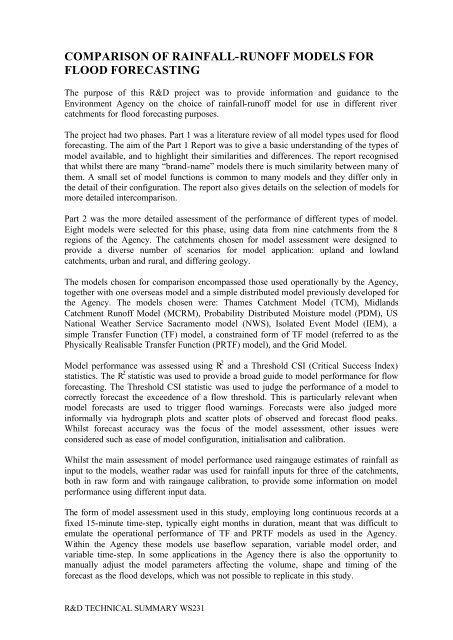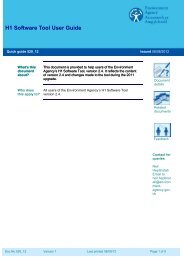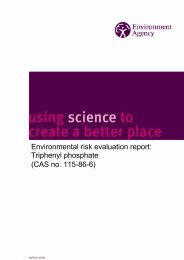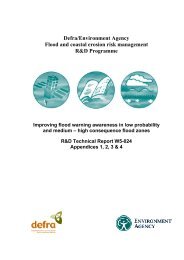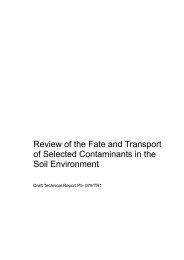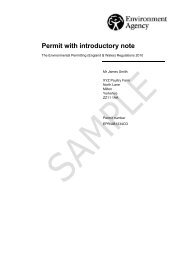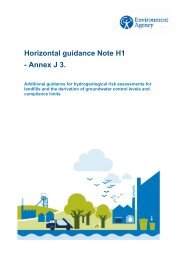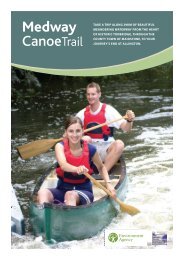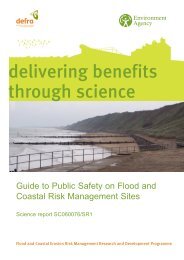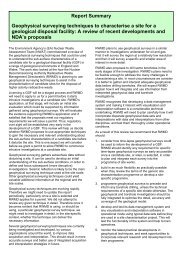comparison of rainfall-runoff models for flood forecasting
comparison of rainfall-runoff models for flood forecasting
comparison of rainfall-runoff models for flood forecasting
You also want an ePaper? Increase the reach of your titles
YUMPU automatically turns print PDFs into web optimized ePapers that Google loves.
COMPARISON OF RAINFALL-RUNOFF MODELS FORFLOOD FORECASTINGThe purpose <strong>of</strong> this R&D project was to provide in<strong>for</strong>mation and guidance to theEnvironment Agency on the choice <strong>of</strong> <strong>rainfall</strong>-run<strong>of</strong>f model <strong>for</strong> use in different rivercatchments <strong>for</strong> <strong>flood</strong> <strong>for</strong>ecasting purposes.The project had two phases. Part 1 was a literature review <strong>of</strong> all model types used <strong>for</strong> <strong>flood</strong><strong>for</strong>ecasting. The aim <strong>of</strong> the Part 1 Report was to give a basic understanding <strong>of</strong> the types <strong>of</strong>model available, and to highlight their similarities and differences. The report recognisedthat whilst there are many “brand-name” <strong>models</strong> there is much similarity between many <strong>of</strong>them. A small set <strong>of</strong> model functions is common to many <strong>models</strong> and they differ only inthe detail <strong>of</strong> their configuration. The report also gives details on the selection <strong>of</strong> <strong>models</strong> <strong>for</strong>more detailed inter<strong>comparison</strong>.Part 2 was the more detailed assessment <strong>of</strong> the per<strong>for</strong>mance <strong>of</strong> different types <strong>of</strong> model.Eight <strong>models</strong> were selected <strong>for</strong> this phase, using data from nine catchments from the 8regions <strong>of</strong> the Agency. The catchments chosen <strong>for</strong> model assessment were designed toprovide a diverse number <strong>of</strong> scenarios <strong>for</strong> model application: upland and lowlandcatchments, urban and rural, and differing geology.The <strong>models</strong> chosen <strong>for</strong> <strong>comparison</strong> encompassed those used operationally by the Agency,together with one overseas model and a simple distributed model previously developed <strong>for</strong>the Agency. The <strong>models</strong> chosen were: Thames Catchment Model (TCM), MidlandsCatchment Run<strong>of</strong>f Model (MCRM), Probability Distributed Moisture model (PDM), USNational Weather Service Sacramento model (NWS), Isolated Event Model (IEM), asimple Transfer Function (TF) model, a constrained <strong>for</strong>m <strong>of</strong> TF model (referred to as thePhysically Realisable Transfer Function (PRTF) model), and the Grid Model.Model per<strong>for</strong>mance was assessed using R 2 and a Threshold CSI (Critical Success Index)statistics. The R 2 statistic was used to provide a broad guide to model per<strong>for</strong>mance <strong>for</strong> flow<strong>for</strong>ecasting. The Threshold CSI statistic was used to judge the per<strong>for</strong>mance <strong>of</strong> a model tocorrectly <strong>for</strong>ecast the exceedence <strong>of</strong> a flow threshold. This is particularly relevant whenmodel <strong>for</strong>ecasts are used to trigger <strong>flood</strong> warnings. Forecasts were also judged morein<strong>for</strong>mally via hydrograph plots and scatter plots <strong>of</strong> observed and <strong>for</strong>ecast <strong>flood</strong> peaks.Whilst <strong>for</strong>ecast accuracy was the focus <strong>of</strong> the model assessment, other issues wereconsidered such as ease <strong>of</strong> model configuration, initialisation and calibration.Whilst the main assessment <strong>of</strong> model per<strong>for</strong>mance used raingauge estimates <strong>of</strong> <strong>rainfall</strong> asinput to the <strong>models</strong>, weather radar was used <strong>for</strong> <strong>rainfall</strong> inputs <strong>for</strong> three <strong>of</strong> the catchments,both in raw <strong>for</strong>m and with raingauge calibration, to provide some in<strong>for</strong>mation on modelper<strong>for</strong>mance using different input data.The <strong>for</strong>m <strong>of</strong> model assessment used in this study, employing long continuous records at afixed 15-minute time-step, typically eight months in duration, meant that was difficult toemulate the operational per<strong>for</strong>mance <strong>of</strong> TF and PRTF <strong>models</strong> as used in the Agency.Within the Agency these <strong>models</strong> use baseflow separation, variable model order, andvariable time-step. In some applications in the Agency there is also the opportunity tomanually adjust the model parameters affecting the volume, shape and timing <strong>of</strong> the<strong>for</strong>ecast as the <strong>flood</strong> develops, which was not possible to replicate in this study.R&D TECHNICAL SUMMARY WS231
The results reported in this study relate to TF/PRTF <strong>models</strong> used without baseflowseparation, using an automated method <strong>of</strong> model parameter adjustment and using a fixedmodel time-step and model order. Results given in the Part 2 report, relating to TF/PRTF<strong>models</strong> should be interpreted against these constraints and background.Overall, the results suggest that no one model consistently out-per<strong>for</strong>ms all others acrossall catchments. Each model gave good per<strong>for</strong>mance in the right situation, with the choice<strong>of</strong> which model to use depending on the complexity <strong>of</strong> catchment response. Use <strong>of</strong> radardata gave as good, and sometimes slightly better, results than using raingauge data alone,provided the radar was functioning well, and raingauge calibration generally helped.Recommendations on possible model use in each Agency region are given. Opportunities<strong>for</strong> further research on model <strong>for</strong>mulation and configuration, updating schemes, andcatchment-scale <strong>rainfall</strong> estimation are identified.The in<strong>for</strong>mation from this R&D project is principally <strong>for</strong> use by Environment Agency staffinvolved in the selection <strong>of</strong> <strong>models</strong> <strong>for</strong> <strong>flood</strong> <strong>for</strong>ecasting purposes. Some <strong>of</strong> the in<strong>for</strong>mationmay be used in future R&D work, such as that led by the National Flood Warning Centre.The in<strong>for</strong>mation contained in the reports may also be <strong>of</strong> interest to Agency staff involvedin hydrological modelling in other fields, such as water resources.This R & D Technical Summary relates to in<strong>for</strong>mation from Project W5-005 contained inthe following outputs:R & D Technical Report W241: Comparison <strong>of</strong> different <strong>for</strong>ecasting <strong>models</strong>, Part 1:Literature review <strong>of</strong> <strong>models</strong>. ISBN: 1 857 05396 6Internal Status: Released to RegionsExternal Status: Released to Public DomainR & D Technical Report W242: Comparison <strong>of</strong> different <strong>for</strong>ecasting <strong>models</strong>, Part 2:Calibration and evaluation <strong>of</strong> <strong>models</strong>.ISBN: 1 857 05397 4Internal Status: Limited releaseExternal Status: RestrictedProject Manager: Owen Wedgwood (North West Region)/ Nigel Outhwaite (ThamesRegion)Research Contractor: Centre <strong>for</strong> Ecology and Hydrology (<strong>for</strong>merly the Institute <strong>of</strong>Hydrology), Walling<strong>for</strong>dCopies <strong>of</strong> the Technical Report are available from each Regional In<strong>for</strong>mation Centre(Library) or the National In<strong>for</strong>mation Centre in Bristol, and externally from theEnvironment Agency R&D dissemination Centre, c/o WRc, Frankland Road, Blagrove,Swindon, Wiltshire SN5 8YF, Tel: 01793 865012, Fax 01793 513562© Environment AgencyRio HouseWaterside DriveAztec WestAlmondsbury Tel: 01454 624400Bristol, BS32 4UD Fax: 01454 624409R&D TECHNICAL SUMMARY WS231


